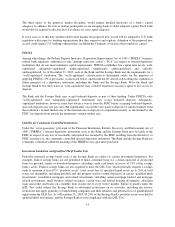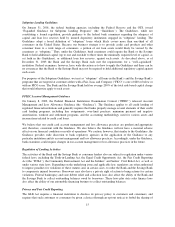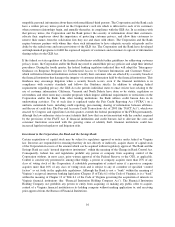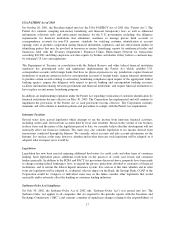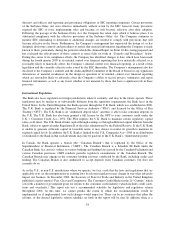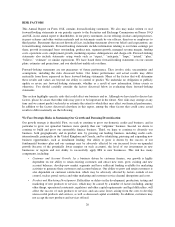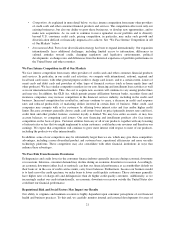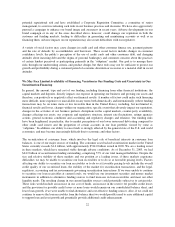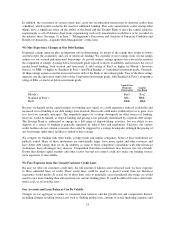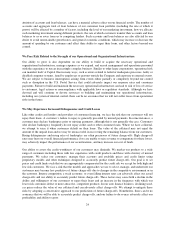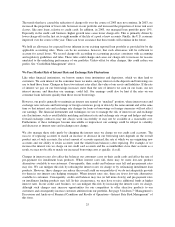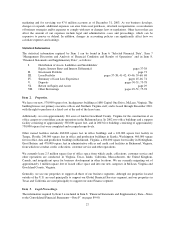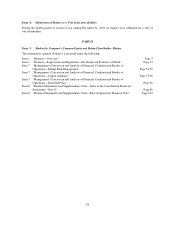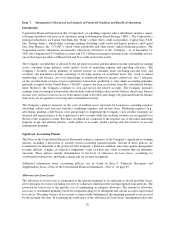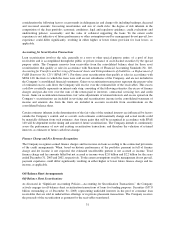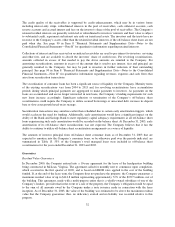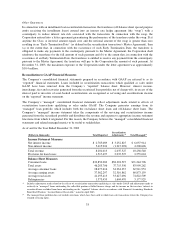Capital One 2003 Annual Report Download - page 42
Download and view the complete annual report
Please find page 42 of the 2003 Capital One annual report below. You can navigate through the pages in the report by either clicking on the pages listed below, or by using the keyword search tool below to find specific information within the annual report.attrition of accounts and loan balances, can have a material adverse effect on our financial results. The number of
accounts and aggregate total of loan balances of our consumer loan portfolio (including the rate at which it
grows) will be affected by a number of factors, including the level of our marketing investment, how we allocate
such marketing investment among different products, the rate at which customers transfer their accounts and loan
balances to us or away from us to competing lenders. Such accounts and loan balances are also affected by our
desire to avoid unsustainable growth rates, and general economic conditions, which may increase or decrease the
amount of spending by our customers and affect their ability to repay their loans, and other factors beyond our
control.
We Face Risk Related to the Strength of our Operational and Organizational Infrastructure
Our ability to grow is also dependent on our ability to build or acquire the necessary operational and
organizational infrastructure, manage expenses as we expand, and recruit management and operations personnel
with the experience to run an increasingly complex business. Similar to other large corporations, operational risk
can manifest itself at Capital One in many ways, such as errors related to failed or inadequate processes, faulty or
disabled computer systems, fraud by employees or persons outside the Company and exposure to external events.
We are subject to business interruptions arising from events either partially or completely beyond our control
such as disruption in the U.S. Postal Service that could adversely impact our response rates and consumer
payments. Failure to build and maintain the necessary operational infrastructure can lead to risk of loss of service
to customers, legal actions or noncompliance with applicable laws or regulatory standards. Although we have
devoted and will continue to devote resources to building and maintaining our operational infrastructure,
including our system of internal control, there can be no assurance that we will not suffer losses from operational
risks in the future.
We May Experience Increased Delinquencies and Credit Losses
Like other credit card lenders and providers of consumer financing, we face the risk that our customers will not
repay their loans. A customer’s failure to repay is generally preceded by missed payments. In some instances, a
customer may declare bankruptcy prior to missing payments, although this is not generally the case. Customers
who declare bankruptcy frequently do not repay credit card or other consumer loans. Where we have collateral,
we attempt to seize it when customers default on their loans. The value of the collateral may not equal the
amount of the unpaid loan and we may be unsuccessful in recovering the remaining balance from our customers.
Rising delinquencies and rising rates of bankruptcy are often precursors of future charge-offs. High charge-off
rates may hurt our overall financial performance if we are unable to raise revenue to compensate for these losses,
may adversely impact the performance of our securitizations, and may increase our cost of funds.
Our ability to assess the credit worthiness of our customers may diminish. We market our products to a wide
range of customers including those with less experience with credit products and those with a history of missed
payments. We select our customers, manage their accounts and establish prices and credit limits using
proprietary models and other techniques designed to accurately predict future charge-offs. Our goal is to set
prices and credit limits such that we are appropriately compensated for the credit risk we accept for both high and
low risk customers. We face a risk that the models and approaches we use to select, manage, and underwrite our
customers may become less predictive of future charge-offs due to changes in the competitive environment or in
the economy. Intense competition, a weak economy, or even falling interest rates can adversely affect our actual
charge-offs and our ability to accurately predict future charge-offs. These factors may cause both a decline in the
ability and willingness of our customers to repay their loans and an increase in the frequency with which our
lower risk customers defect to more attractive, competitor products. In our auto finance business, declining used-
car prices reduce the value of our collateral and can adversely affect charge-offs. We attempt to mitigate these
risks by adopting a conservative approach to our predictions of future charge-offs. Nonetheless, there can be no
assurance that we will be able to accurately predict charge-offs, and our failure to do so may adversely affect our
profitability and ability to grow.
24


